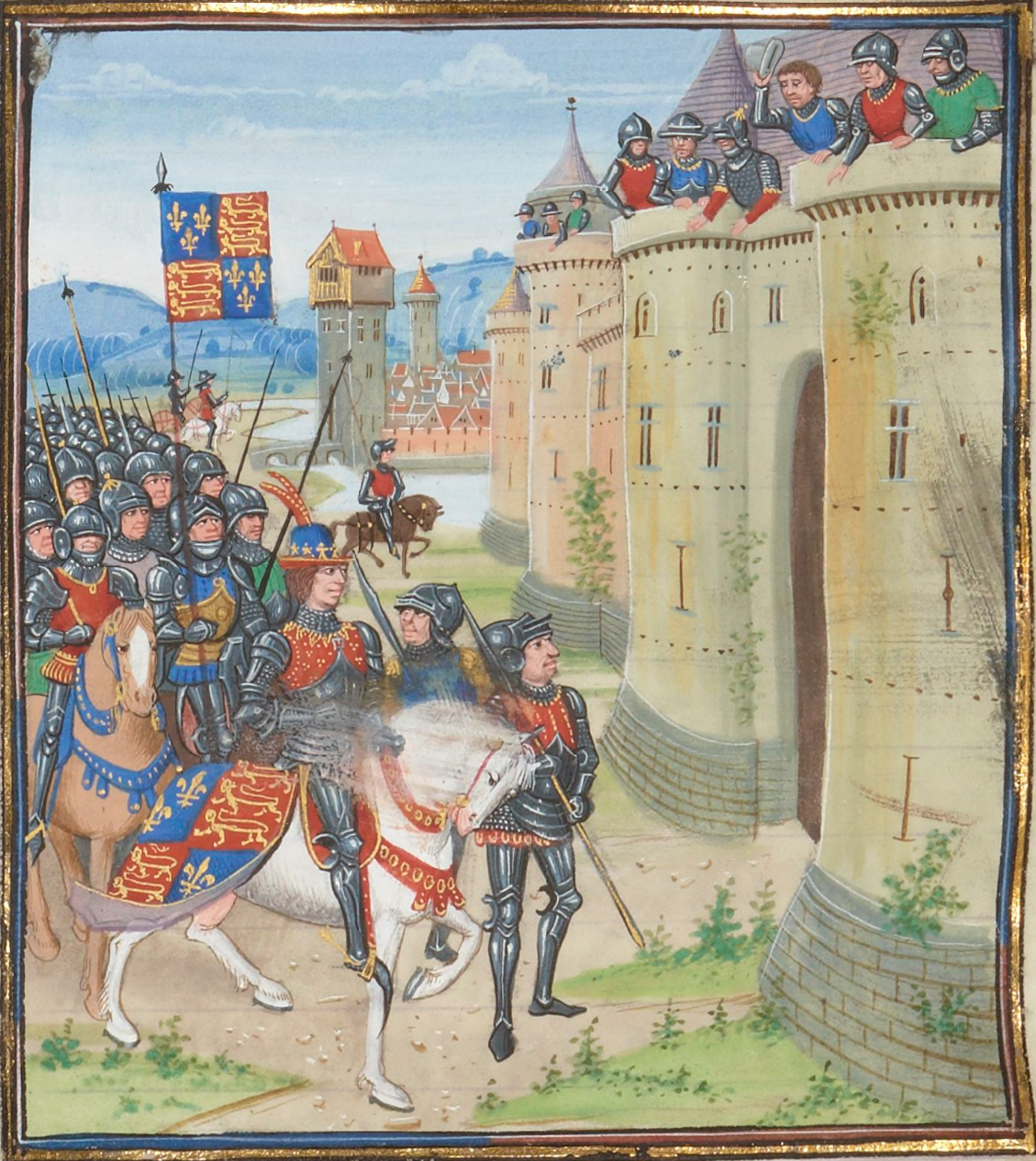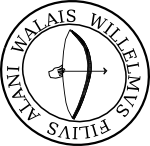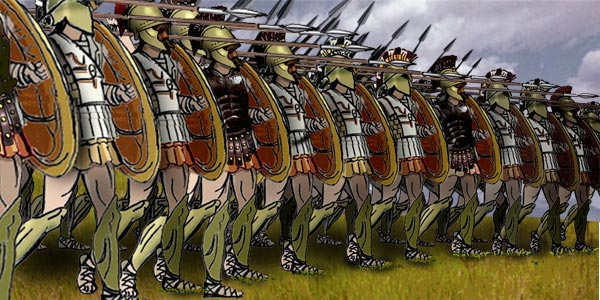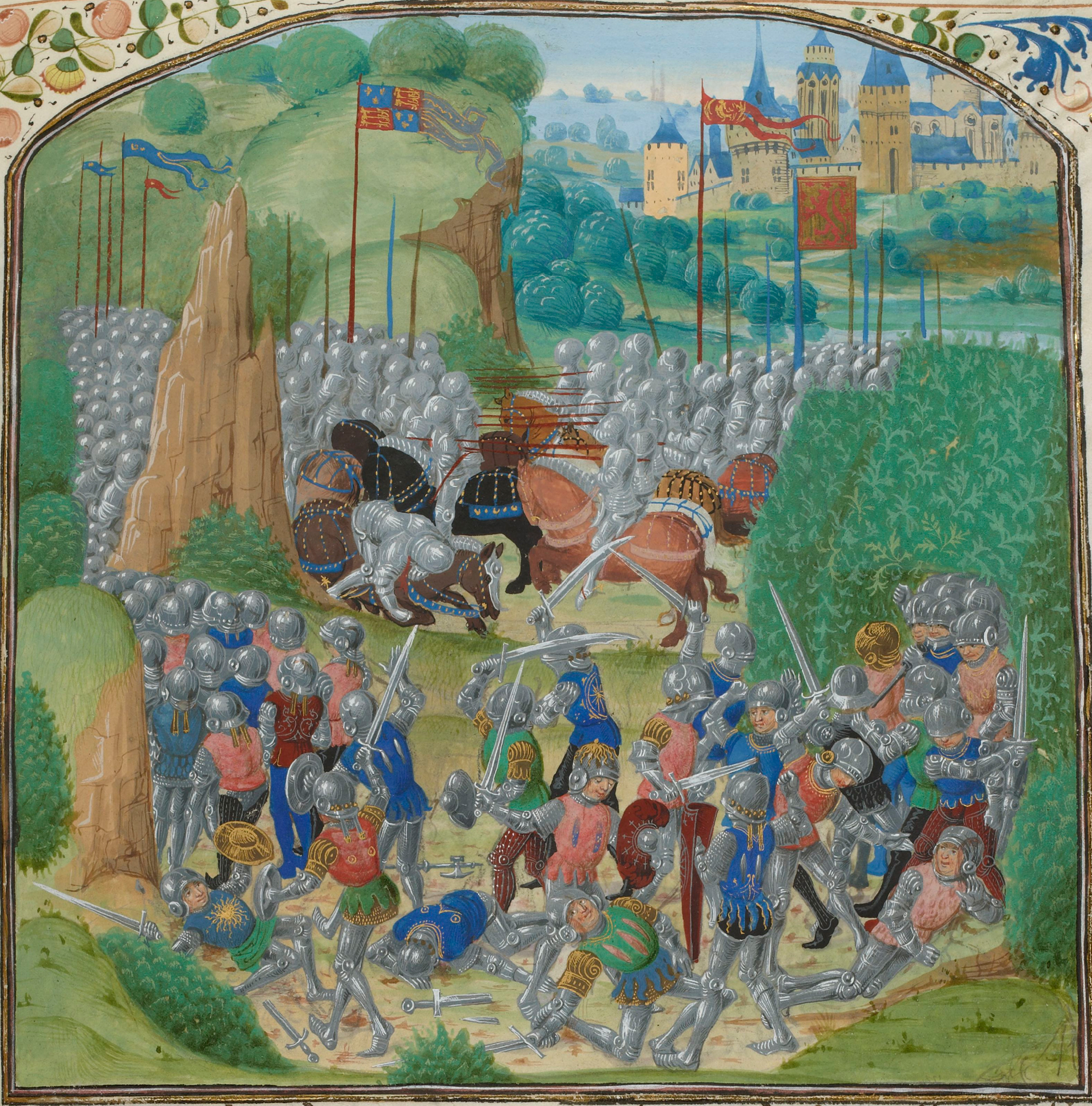|
Schiltron
A schiltron (also spelled sheltron, sceld-trome, schiltrom, or shiltron) is a compact body of troops forming a battle array, shield wall or phalanx. The term is most often associated with Scottish pike formations during the Wars of Scottish Independence in the late 13th and early 14th centuries. Etymology The term dates from at least 1000 AD and derives from Old English roots expressing the idea of a "shield-troop". Some researchers have also posited this etymological relation may show the schiltron is directly descended from the Anglo-Saxon shield wall, and still others give evidence "schiltron" is a name derived from a Viking circular formation (generally no fewer than a thousand fighters) in extremely close formation, intended to present an enemy's cavalry charge with an "infinite" obstacle (that is, a perimeter horses refuse to breach). Matters are confused by use of this term in Middle English to clearly refer to a body of soldiers without reference to formation, includ ... [...More Info...] [...Related Items...] OR: [Wikipedia] [Google] [Baidu] |
Battle Of Dupplin Moor
The Battle of Dupplin Moor was fought between supporters of King David II of Scotland, the son of King Robert Bruce, and English-backed invaders supporting Edward Balliol, son of King John I of Scotland, on 11 August 1332. It took place a little to the south-west of Perth, Scotland, when a Scottish force commanded by Donald, Earl of Mar, estimated to have been stronger than 15,000 and possibly as many as 40,000 men, attacked a largely English force of 1,500 commanded by Balliol and Henry Beaumont, Earl of Buchan. This was the first major battle of the Second War of Scottish Independence. The First War of Scottish Independence between England and Scotland ended in 1328 with the Treaty of Northampton, recognising Bruce as King of Scots, but the treaty was widely resented in England. King Edward III of England was happy to cause trouble for his northern neighbour and tacitly supported an attempt to place Balliol on the Scottish throne. Balliol and a small force landed in Fi ... [...More Info...] [...Related Items...] OR: [Wikipedia] [Google] [Baidu] |
Battle Of Halidon Hill
The Battle of Halidon Hill took place on 19 July 1333 when a Scottish army under Sir Archibald Douglas attacked an English army commanded by King Edward III of England () and was heavily defeated. The year before, Edward Balliol had seized the Scottish Crown from five-year-old David II (), surreptitiously supported by Edward III. This marked the start of the Second War of Scottish Independence. Balliol was shortly expelled from Scotland by a popular uprising, which Edward III used as a ''casus belli'', invading Scotland in 1333. The immediate target was the strategically-important border town of Berwick-upon-Tweed, which the English besieged in March. A large Scottish army advanced to relieve the town. They attempted and failed to draw the English away from Berwick. By mid-July, knowing Berwick was on the verge of surrender and aware they were much stronger than the English, the Scots attacked. They unsuccessfully manoeuvred for position and then launched an assault on the ... [...More Info...] [...Related Items...] OR: [Wikipedia] [Google] [Baidu] |
Battle Of Falkirk
The Battle of Falkirk (; ), on 22 July 1298, was one of the major battles in the First War of Scottish Independence. Led by Edward I of England, King Edward I of England, the English army defeated the Scottish people, Scots, led by William Wallace. Shortly after the battle Wallace resigned as Guardian of Scotland. Background After the Battle of Stirling Bridge, from November 1297 until January 1298 Wallace led a Scottish army south. From Newcastle upon Tyne to Carlisle, the Scots raided the countryside, bringing back the spoils. Edward I of England, King Edward learned of the defeat of his northern army at the Battle of Stirling Bridge. After concluding a truce with the French king, Philip IV of France, Philip the Fair, in October 1297, he returned to England on 14 March 1298 to continue the ongoing organising of an army for his second invasion of Scotland which had been in preparation since late 1297. As a preliminary step, he moved the centre of government to York, where it ... [...More Info...] [...Related Items...] OR: [Wikipedia] [Google] [Baidu] |
Battle Of Bannockburn
The Battle of Bannockburn ( or ) was fought on 23–24 June 1314, between the army of Robert the Bruce, King of Scots, and the army of King Edward II of England, during the First War of Scottish Independence. It was a decisive victory for Robert Bruce and formed a major turning point in the war, which ended 14 years later with the ''de jure'' restoration of Scottish independence under the Treaty of Edinburgh–Northampton. For this reason, the Battle of Bannockburn is widely considered a landmark moment in Scottish history. King Edward II invaded Scotland after Bruce demanded in 1313 that all supporters still loyal to ousted Scottish king John Balliol acknowledge Bruce as their king or lose their lands. Stirling Castle, a Scots royal fortress occupied by the English, was under siege by the Scottish army. King Edward assembled a formidable force of soldiers to relieve it—the largest army ever to invade Scotland. The English summoned 25,000 infantry soldiers and 2,000 horse ... [...More Info...] [...Related Items...] OR: [Wikipedia] [Google] [Baidu] |
William Wallace
Sir William Wallace (, ; Norman French: ; 23 August 1305) was a Scottish knight who became one of the main leaders during the First War of Scottish Independence. Along with Andrew Moray, Wallace defeated an English army at the Battle of Stirling Bridge in September 1297. He was appointed Guardian of Scotland and served until his defeat at the Battle of Falkirk in July 1298. In August 1305, Wallace was captured in Robroyston, near Glasgow, and handed over to King Edward I of England, who had him hanged, drawn and quartered for high treason and crimes against English civilians. Since his death, Wallace has obtained a legendary status beyond his homeland. He is the protagonist of Blind Harry's 15th-century epic poem '' The Wallace'' and the subject of literary works by Jane Porter and Sir Walter Scott, and of the Academy Award-winning film ''Braveheart''. Background William Wallace was a member of the lesser nobility, but little is definitely known of his family history ... [...More Info...] [...Related Items...] OR: [Wikipedia] [Google] [Baidu] |
Thomas Randolph, 1st Earl Of Moray
Thomas Randolph, Earl of Moray (c. 1285 20 July 1332) was a soldier and diplomat in the Wars of Scottish Independence, who later served as regent of Scotland. He was a nephew of Robert the Bruce, who created him as the first earl of Moray. He was known for successfully capturing Edinburgh Castle from the English, and he was one of the signatories of the Declaration of Arbroath. Early life Thomas was the son of another Thomas, who was Chamberlain of Scotland and Sheriff of Roxburgh, and the grandson of the Randulf or Ranulf who gave the family their surname. It is known that the younger Thomas was the nephew of King Robert the Bruce; his mother was Martha of Kilconquhar, Robert's older half-sister. The traditional view is that she was of the first marriage of Marjorie of Carrick, who was the mother of Robert the Bruce by her second marriage. There has been conjecture that the King's father Robert married again after Marjorie's death and had with his second wife a dau ... [...More Info...] [...Related Items...] OR: [Wikipedia] [Google] [Baidu] |
Pike (weapon)
A pike is a long thrusting spear formerly used in European warfare from the Late Middle Ages and most of the early modern warfare, early modern period, and wielded by infantry, foot soldiers deployed in pike square formation, until it was largely replaced by bayonet-equipped muskets. The pike was particularly well known as the primary weapon of Spanish tercios, Swiss mercenary, German Landsknecht units and French sans-culottes. A similar weapon, the sarissa, had been used in classical antiquity, antiquity by Alexander the Great's Ancient Macedonians, Macedonian phalanx infantry. Design The pike was a long weapon, varying considerably in size, from long. Generally, a spear becomes a pike when it is too long to be wielded with one hand in combat. It was approximately in weight, with the 16th-century military writer John Smith (High Sheriff of Kent), Sir John Smythe recommending lighter rather than heavier pikes. It had a wooden shaft with an iron or steel spearhead affixed. Th ... [...More Info...] [...Related Items...] OR: [Wikipedia] [Google] [Baidu] |
Battle Of Neville's Cross
The Battle of Neville's Cross took place during the Second War of Scottish Independence on 17 October 1346, half a mile (800 m) to the west of Durham, England. An invading Scottish army of 12,000 led by King David II was defeated with heavy loss by an English army of approximately 6,000–7,000 men led by Ralph Neville, Lord Neville. The battle was named after an Anglo-Saxon stone cross that stood on the hill where the Scots made their stand. After the victory, Neville paid to have a new cross erected to commemorate the day. The battle was the result of the invasion of France by England during the Hundred Years' War. King Philip VI of France () called on the Scots to fulfil their obligation under the terms of the Auld Alliance and invade England. David II obliged, and after ravaging much of northern England was taken by surprise by the English defenders. The ensuing battle ended with the rout of the Scots, the capture of their king and the death or capture of most of their le ... [...More Info...] [...Related Items...] OR: [Wikipedia] [Google] [Baidu] |
Battle Of Myton
The Battle of Myton, nicknamed the Chapter of Myton or The White Battle because of the number of clergy involved, was a major engagement in the First Scottish War of Independence, fought in Yorkshire on 20 September 1319. Berwick Falls In April 1318, Berwick-upon-Tweed, the last Scottish stronghold which was in the hands of the English, was captured by Sir James Douglas and Thomas Randolph, Earl of Moray, two of King Robert Bruce's most able commanders. Ever since his defeat at Bannockburn in 1314, Edward II had been preoccupied by an ongoing political struggle with his senior barons, headed by Thomas, Earl of Lancaster. Repeated Scottish raids deep into the north of England had effectively been ignored: but the loss of Berwick was something different. Once the most important port in Scotland, it had been in English hands since 1296; during which time its defences had been greatly strengthened. News of its capture had a sobering effect on Edward and his magnates. Aymer de V ... [...More Info...] [...Related Items...] OR: [Wikipedia] [Google] [Baidu] |
Phalanx
The phalanx (: phalanxes or phalanges) was a rectangular mass military formation, usually composed entirely of heavy infantry armed with spears, pikes, sarissas, or similar polearms tightly packed together. The term is particularly used to describe the use of this formation in ancient Greek warfare, although the ancient Greek writers used it to also describe any massed infantry formation, regardless of its equipment. Arrian uses the term in his ''Array against the Alans'' when he refers to his legions. In Greek texts, the phalanx may be deployed for battle, on the march, or even camped, thus describing the mass of infantry or cavalry that would deploy in line during battle. They marched forward as one entity. The term itself, as used today, does not refer to a distinctive military unit or division (e.g., the Roman legion or the contemporary Western-type battalion), but to the type of formation of an army's troops. Therefore, this term does not indicate a standard combat ... [...More Info...] [...Related Items...] OR: [Wikipedia] [Google] [Baidu] |
Battle Of Otterburn
The Battle of Otterburn, also known as the Battle of Chevy Chase, took place according to Scottish sources on 5 August 1388, or 19 August according to English sources, as part of the continuing border skirmishes between the Scots and English. The Scottish nobles James, 2nd Earl of Douglas and John Dunbar, Earl of Moray led their army toward Durham while Archibald Douglas, 3rd Earl of Douglas at the time Lord of Galloway, and Robert Stewart, Duke of Albany, at the time Earl of Fife, coordinated a simultaneous attack on Carlisle Castle. It was timed to take advantage of divisions on the English side between Ralph Neville, 1st Earl of Westmorland and Henry Percy, 1st Earl of Northumberland who had just taken over defence of the border and partly in revenge for King Richard II's invasion of Scotland three years previously. Battle The Scots fielded two armies, with Archibald Douglas's force and their baggage train heading to attack Carlisle, while another force under t ... [...More Info...] [...Related Items...] OR: [Wikipedia] [Google] [Baidu] |
Robert I Of Scotland
Robert I (11 July 1274 – 7 June 1329), popularly known as Robert the Bruce (), was King of Scots from 1306 until his death in 1329. Robert led Kingdom of Scotland, Scotland during the First War of Scottish Independence against Kingdom of England, England. He fought successfully during his reign to restore Scotland to an independent kingdom and is regarded in Scotland as a folk hero, national hero. Robert was a fourth-great-grandson of King David I, and his grandfather, Robert de Brus, 5th Lord of Annandale, was one of the claimants to the Scottish throne during the "Great Cause". As Earl of Carrick, Robert the Bruce supported his family's claim to the Scottish throne and took part in William Wallace's campaign against Edward I of England. Appointed in 1298 as a Guardian of Scotland alongside his chief rival for the throne, John Comyn of Badenoch, and William Lamberton, Bishop of St Andrews, Robert resigned in 1300 because of his quarrels with Comyn and the apparently imminen ... [...More Info...] [...Related Items...] OR: [Wikipedia] [Google] [Baidu] |






